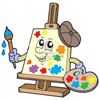Positive Psychology
The Art of Positive Psychology
The positive psychology teacher is an artist.
Posted November 26, 2012

Do you use lessons to assist students in the discovery of an exciting subject? Do you help them discover the answers to interesting and important questions about themselves and their world? Do you ask questions answered by philosophy, history, literature, politics, and more? Do you teach students the arithmetic, science, and languages of their world? Do you also assist in the self-discovery of emotions and strengths?
When you teach the algebraic equation, do you also teach the formula for sharing knowledge with others? When you teach the unique characteristics of the planets, do you also teach about the unique characteristics of the person?
The art of positive psychology is a multi-dimensional, mixed-media art form that avoids compartmentalized, discipline-discrete instruction and embraces integrative, multi-discipline-enriched teaching. How fast did Paul Revere travel on his midnight ride through Boston? How far did he travel? Were there other faster or shorter routes through town? What year was it? What other important events occurred in that same year? Was his message important? How did he feel riding fast through the dark? What strengths does Longfellow capture in his famous poem about him?
As in art, every subject that must be mastered - and every skill that must be acquired - is the basis for cognitive, affective, and conative development. What can I know about this person, place, or thing? What do I feel? What action can I take, what problem can I solve, what project can I complete? Carl Jung described the art of teaching in this way, “One looks back with appreciation to the brilliant teachers, but with gratitude to those who touched our feelings.”
The positive psychology teacher adopts a new taxonomy. Taxonomy is the science of categorizing related concepts and education taxonomies classify the content -- or the subject taught. Defining and developing an educational taxonomy is the first step in building learning structure and content. Before the teacher can teach effectively, they must determine what to teach. Educational taxonomies that identify categories of learning and instructional goals generate a curricular map for the teacher to follow.
While traditional educational taxonomies are primarily concerned with how to best teach subject area content and how to build a child’s academic knowledge -- reading, writing, and arithmetic taxonomies also need to address what to teach so as to develop well-rounded children who learn to thrive in the school setting and throughout their adult lives. Education must address more than the accumulation of subject-area knowledge. New taxonomies must incorporate emotional education into the more traditional education paradigm.
The new taxonomy of positive psychology teaching creates a new mosaic of cognitive and emotional learning. The art of positive psychology is the art of self-discovery.
What will your students discover about themselves, others, and their world today?
What picture will they paint?
Notes
Explore: Schools as Ecosystems http://schoolecosystem.blogspot.com
Read: A Primer on Teaching Positive Psychology http://www.apa.org/monitor/oct03/primer.aspx
Review: Bloom’s Taxonomies http://www.nwlink.com/~donclark/hrd/bloom.html
Visit: The Paul Revere House http://www.paulreverehouse.org
I would love to hear from you. Do you think teaching is more art or science? How is it an art? What medium of art expression is analogous? Are you familiar with Bloom’s affective taxonomy? Do you think the three domains of Bloom’s learning taxonomy are given equal attention in the classroom? How do you balance the teaching of the cognitive and affective taxonomy in your classroom? What is an example of a lesson that you use to teach cognitive, affective, and conative learning using an interdisciplinary approach or the “mosaic” effect?
----------
My upcoming book, Positive Psychology in the Elementary School Classroom, is the first in a series intended to help teachers build positive psychology classrooms. http://books.wwnorton.com/books/Author.aspx?id=23961
Visit me on Facebook https://www.facebook.com/drogrady
Follow me on Twitter https://twitter.com/pattyogrady
Join my Circles on Google+ https://plus.google.com/111049584788707351855


